China’s Xi speaks with Trump by phone, discusses Taiwan and bilateral ties
Last week, we discussed that the market backdrop improved markedly following commentary from the White House that eased concerns about tariffs. To wit:
“The market rallied above the 20-DMA this past week as investors found some “silver linings” to the ongoing tariff dispute. Despite China saying “no negotiations” had started with the U.S., comments from both President Trump and Scott Bessent suggested that the Administration would “be nice” to China and that a “very good deal” could be done between the two countries.
As we have noted previously, given the more extreme oversold condition of the market, any “good news” would allow investors to push stocks higher.”
This past week, two reports confirmed the economy is slowing. First, there was the weak GDP report, which showed growth of roughly one percent, after discounting the impact of the trade deficit. Secondly, while the employment number was higher than expected, the job growth trend is also slowing.
However, those reports should have tempered market enthusiasm as they reduced hopes for Fed rate cuts. However, the market pushed higher as investors raced to jump back into “risk assets” as the market cleared initial resistance at the 20-DMA and reversed all of the “Liberation Day” losses.
As we noted in “Hope In The Fear,”, it would take much for the market to mount a sizeable rally given the extremely negative sentiment and positioning. Last week, the potential break in the China stalemate and non-recessionary data fed the “short-covering” rally, and pushed the index above the 50-DMA. That rally has also reversed the more extreme bearish sentiment and pushed the number of stocks on “bullish buy signals” back to 70%.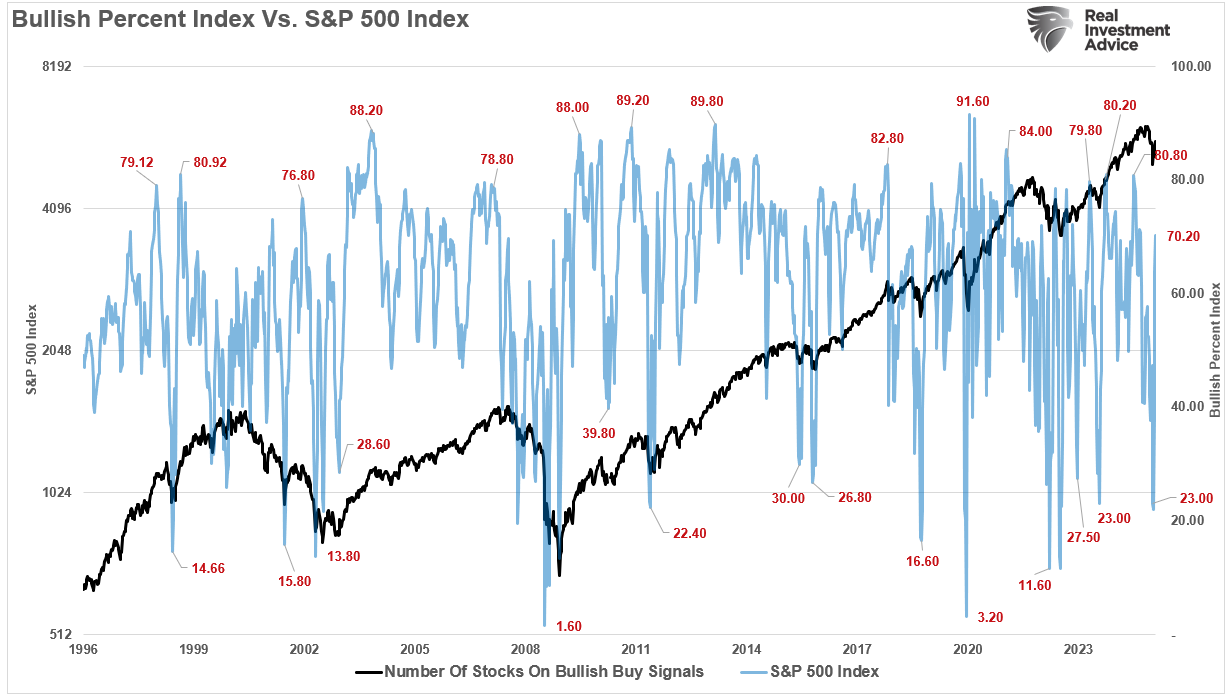
Notably, the rally from the recent lows, which has seen the market rise for nine consecutive days, is one of the longest win streaks in 20 years.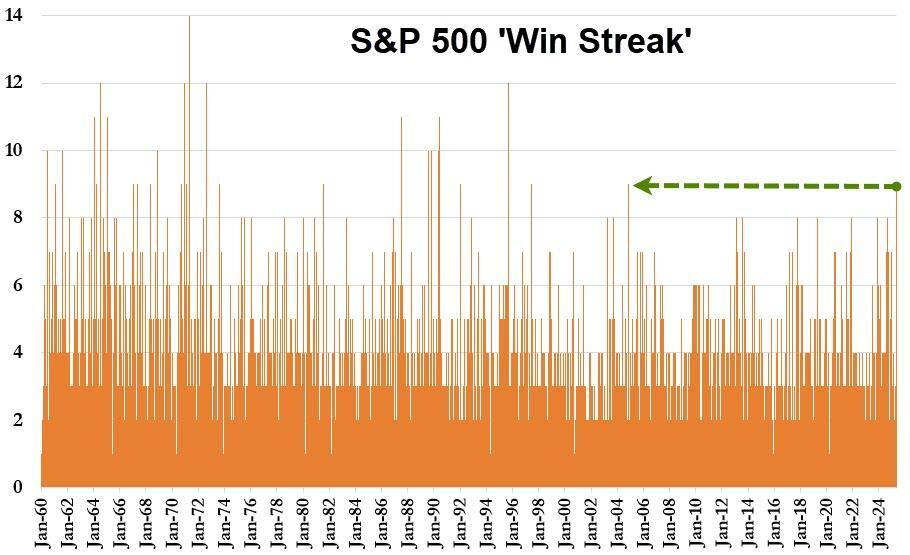
What should be notable about that statement is that all “win streaks” end, eventually. That statement does not mean the markets will crash, but given that the rally has pushed markets back into short-term overbought conditions. Furthermore, the 200- and 100-DMA will provide notable resistance to the continuation of this rally without a pullback first.
As we noted previously, many “trapped longs” will look to exit the market as we approach full recovery from the “tariff breakdown.”
Two Reasons To Be More Bullish
While bullish that the market has recovered 61.8% of its recent correction, a pullback should be expected. If you haven’t rebalanced allocations and reduced risk somewhat, now is the time. However, look for retracements to the 50-DMA, then the recent support, and finally the 20-DMA as areas to rebuild equity exposure. Lastly, move stop losses in portfolios up to the 20-DMA for trading positions.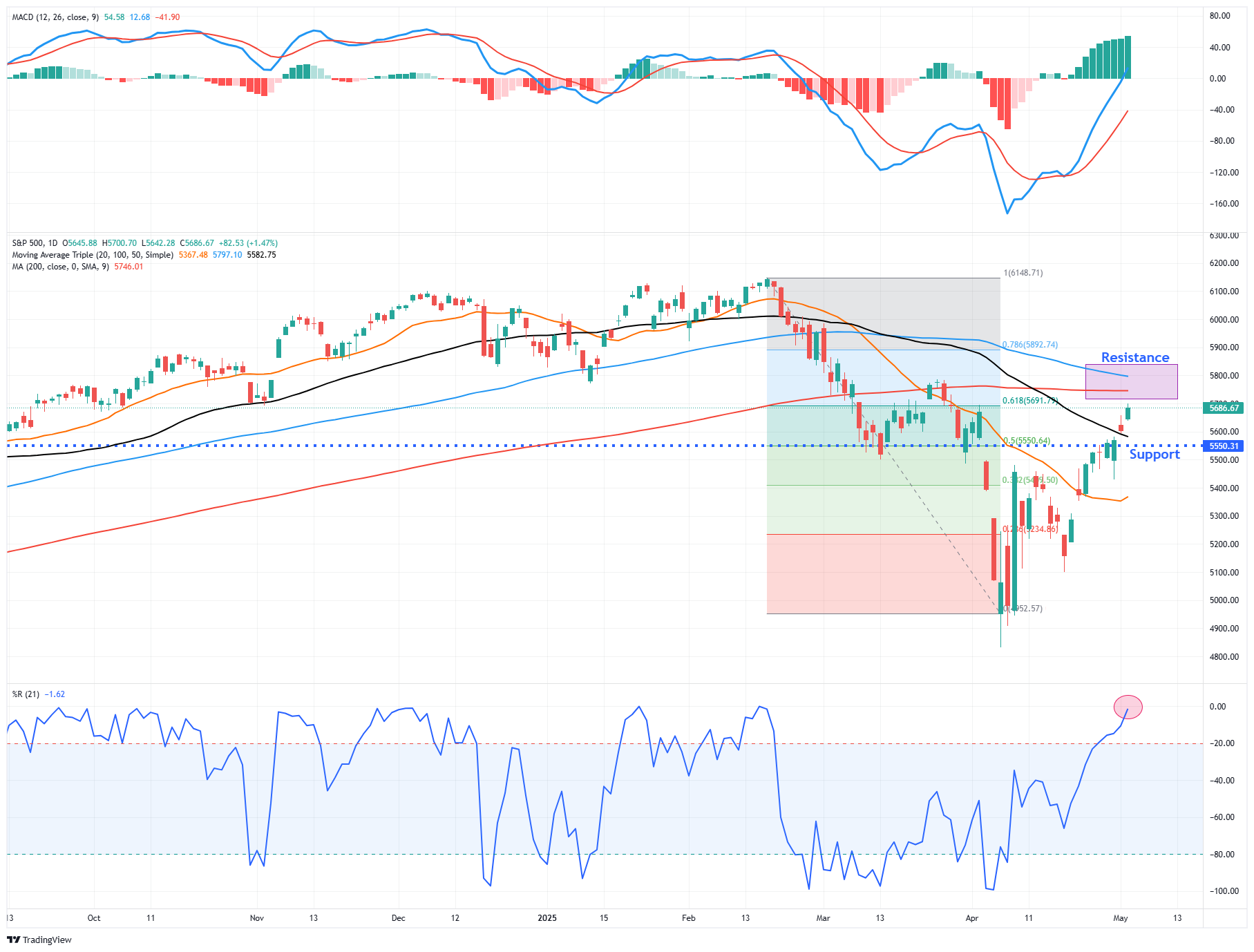
There are two reasons to be more constructive about the market over the coming month.
First, May tends to be a better-performing month following Presidential elections, while June tends to be weak (hence the Wall Street axiom “Sell In May.”)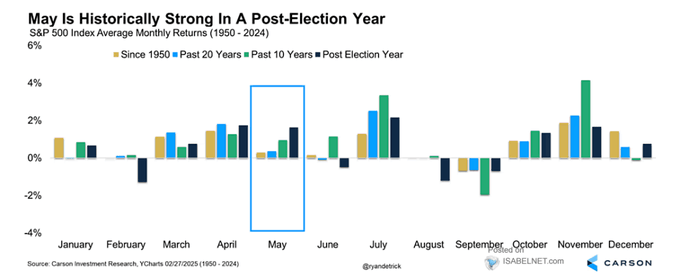
Secondly, after a sharp reversal in April, which fueled the market selloff, share repurchases return next week as the bulk of the S&P 500 has announced earnings.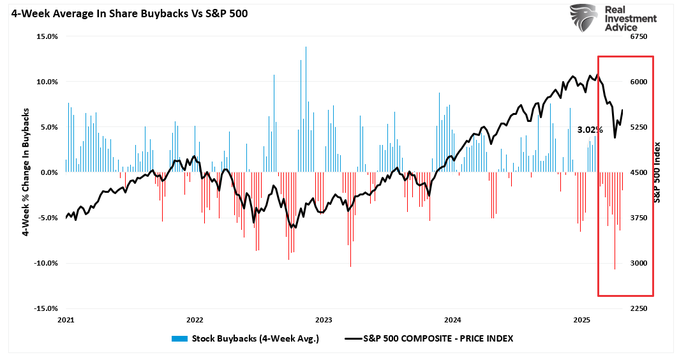
Optimism is returning to the market with economic data mainly remaining stable, earnings season coming in “better-than-expected,” and the near-term tariff threat residing. However, as noted, we suggest being somewhat cautious following the recent sharp advance and using short-term pullbacks to recent support to reduce hedges and increase equity risk as needed.
As we advance into 2025, we expect volatility to remain a constant companion. This will be a function of both the realization that economic growth is slowing and the repricing of valuations as earnings estimates are revised lower to meet reality.
Economic Decline Is Gaining Momentum
Given the recent strength in the economic data, we are not in the “recession” camp. However, there is little argument that an economic decline is gaining momentum. However, that decline should not be surprising since we repeatedly discussed it last year. To wit:
“One of the primary reasons why the economy has defied the recessionary drag from higher borrowing costs has been the ample supply of fiscal support through previously passed spending bills such as the Inflation Reduction Act and the CHIPs Act. When combined with stimulus checks, tax credits, and moratoriums on various debt payments like rent and student loans, the amount of monetary support for consumption supported economic growth as the Federal Reserve tightened monetary policy.”
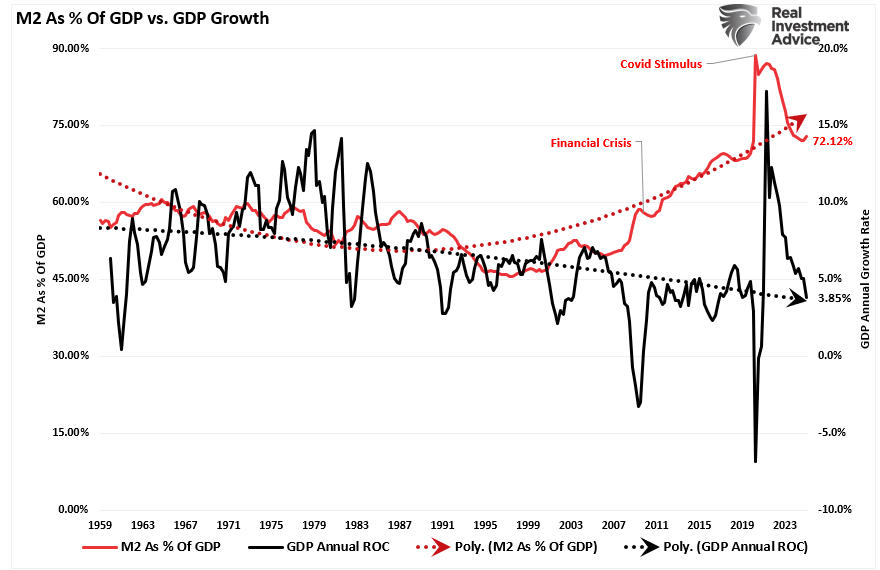
What is crucial to understand is that the surge in monetary support acted as an “adrenaline” boost to the economy. Yes, many economic data series suggest the risk of recession is elevated. However, the surge of monetary injections sent the economy into overdrive, as evidenced by economic growth in 2021.
You can see this clearly in the chart below, which shows the annual rate of change in federal spending versus economic growth. As federal spending has slowed, so has the economy’s annual growth rate.
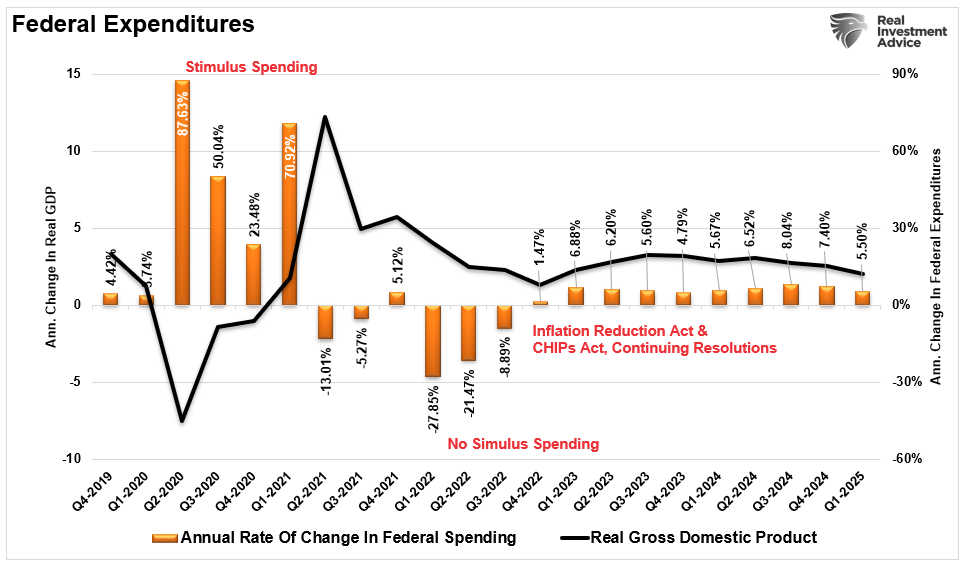
As we noted last year, the crucial point that continues to elude most economists is that the economic decline will gain traction as that “adrenaline” boost fades. Had the economy been growing at 5% nominal, as in 2019, the decline from the post-pandemic peak would already register a recession.
However, given that nominal growth neared 18%, it has taken far longer than many expected for economic decline to return to previous norms of just 2% annual growth.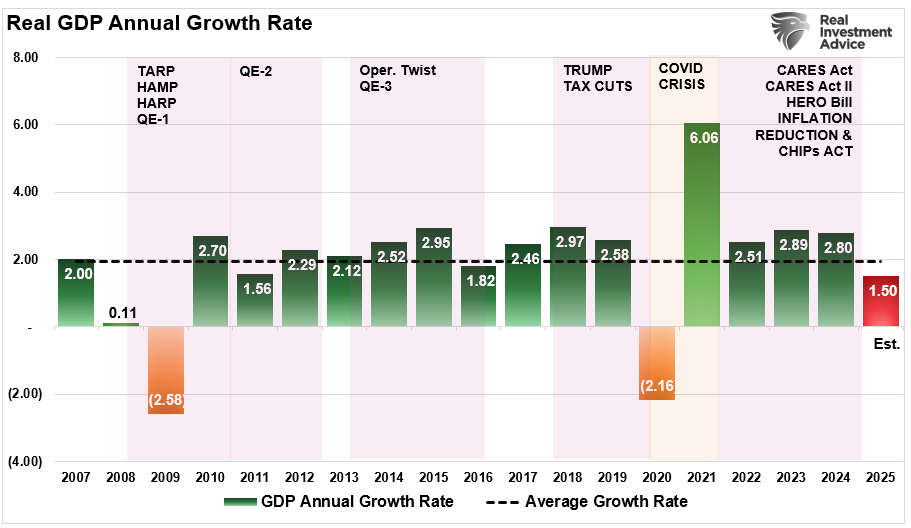
In that previous article, we explained how the economic decline would take time to return to norms. To show this, we looked at the number of quarters between peak economic activity and the entrance into a recession. Using that historical analysis, we estimated that reversing economic growth into a recession could take roughly 22 quarters. Such would target the next downturn in late 2025 to mid-2026.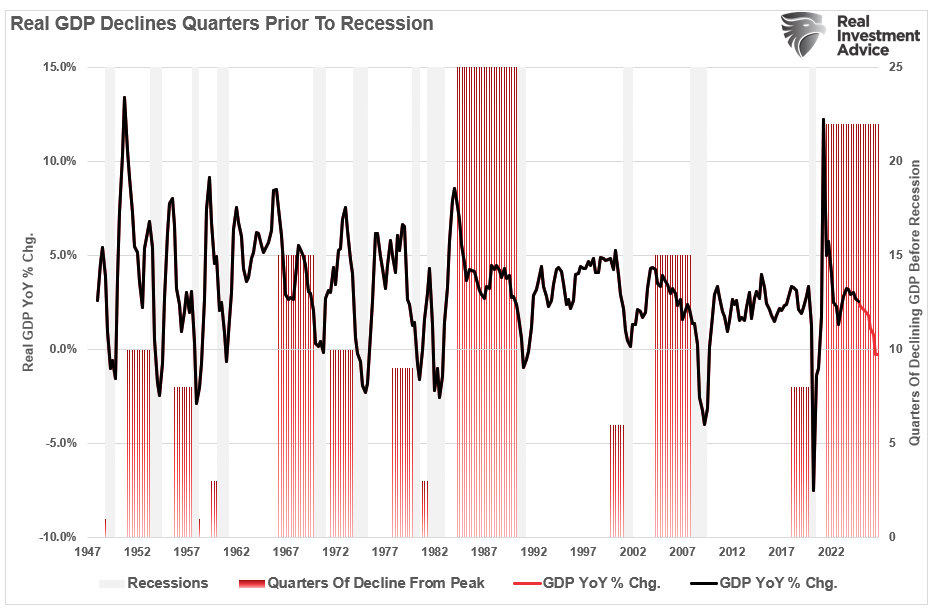
As we concluded then, many things could certainly happen to lengthen or shorten that estimated time frame. However, the importance is that an economic decline from elevated economic growth rates can take much longer than usual. Another similar period was the 25 quarters of slowing economic growth before the 1991 recession.
However, that analysis was “so last year.” Things have certainly changed, particularly given the current Administration’s tariffs and the potential impact on economic growth that those could foster. We have already seen a fairly sharp downturn in key economic indicators, showing that the economic decline is accelerating.
That data appeared this past week in the Q1-GDP report, which showed a negative print for Q1 caused entirely by the front-running of tariffs, which created a record trade deficit. The BEA noted this following the release of the data.
“The decrease in real GDP in the first quarter primarily reflected an increase in imports, which are a subtraction in the calculation of GDP, and a decrease in government spending. These movements were partly offset by increases in investment, consumer spending, and exports.”
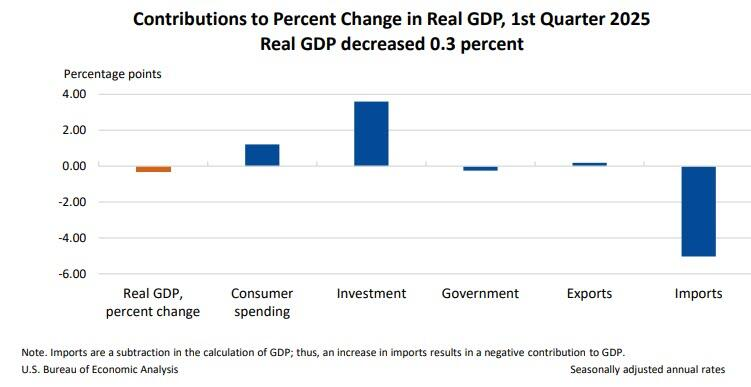
Simultaneously, despite concerns about tariffs, the “stagflation” concerns were crushed by a drop in the Personal Consumption Expenditure (PCE) price index, which fell to just 2.3% annually.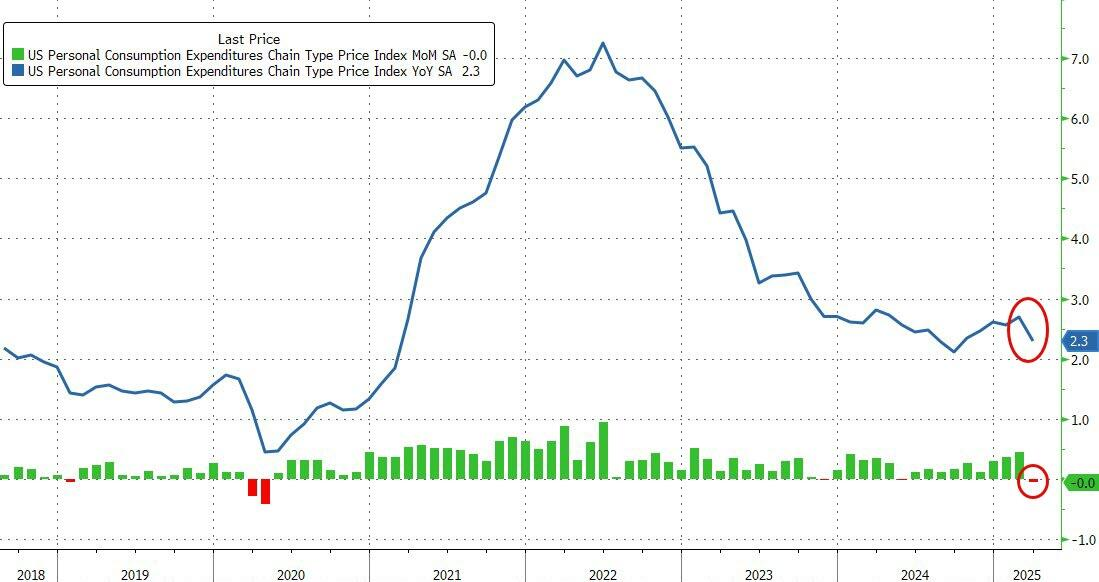
So, the key question for investors is, where are we headed next? Economic slowdown or recession?
Key Indicators We Are Watching
There is currently no evidence that the economy is slipping into a recession. However, if you want to know if an economic decline will evolve into a recession, there is one key factor to consider: consumer spending. Consumer spending comprises nearly 70% of the GDP calculation, and everything else, from business investment to imports and exports, is a function of the consumer’s “demand.”
In other words, if the consumer is slowing down or contracting spending, businesses will not “invest” in expansion projects, increasing employment, or buying more products for resale. That relationship is shown in the chart below, which compares PCE to employment and private investment.
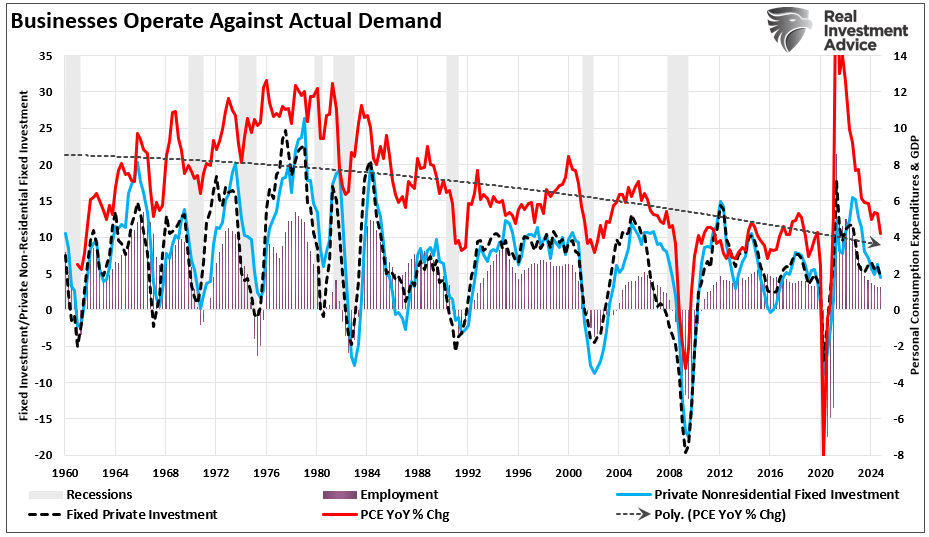
As such, watching the consumer is critical to estimating economic outcomes. As we discussed in “The Consumer Is Tapping Out,”
“While GDP surged following the economic shutdown due to the massive flood of stimulus that fueled a savings surge, consumption as a percent of the economy has remained flat since the turn of the century. The reason is that despite the surge in savings, the consumer was also faced with rising inflation, which left them struggling to make ends meet.”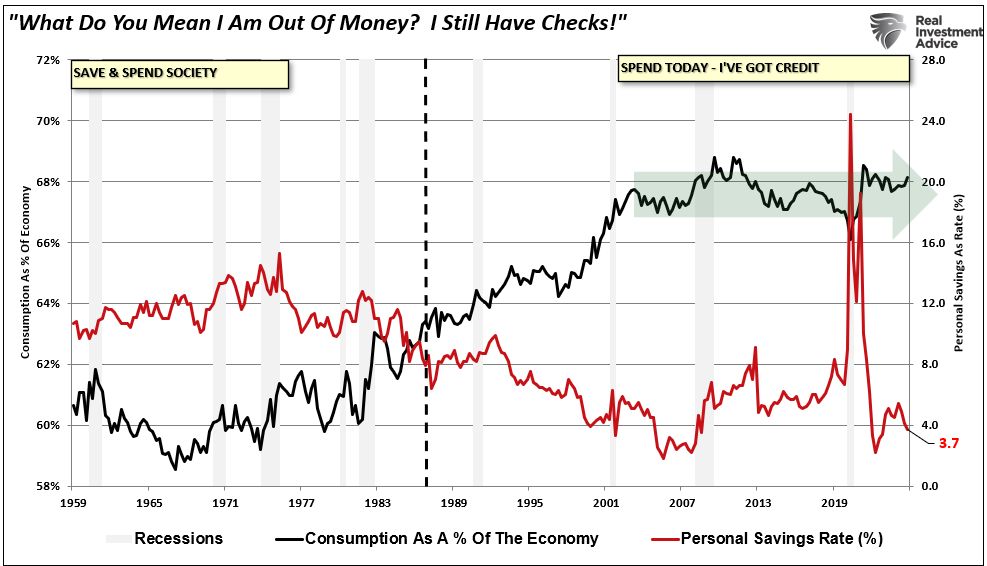
“This dilemma is better illustrated by the chart below. The blue line is the personal savings rate, and the red line shows the debt needed annually to bridge the gap between the inflation-adjusted cost of living and savings and incomes. As shown, at the turn of the century, the consumer could no longer fund their living standard through just income and savings. The fact that consumers were forced to take on increasing debt levels to maintain their living standards explains why consumption as a percent of GDP has remained stagnant over the same period.”
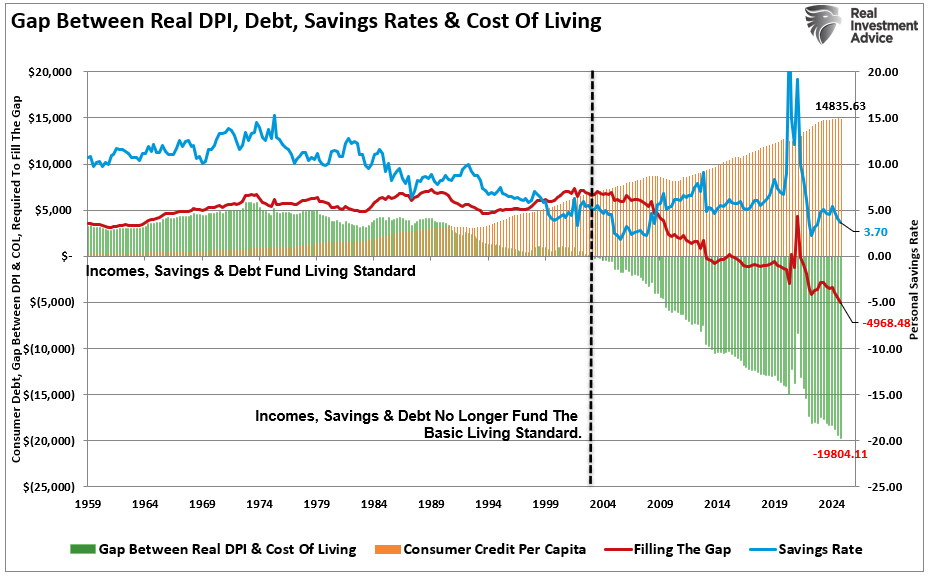
At the heart of the problem is the collapse of household balance sheets in the lower-income and middle-income brackets. These groups have depleted the excess savings accumulated during the pandemic and are now facing increasing pressures to maintain their standard of living. Here are a few examples:
- The Philadelphia Federal Reserve reported that the share of active credit card accounts making only minimum payments surged to 10.75% in Q3 2024—a record high.
- Credit card delinquency rates have increased 33 basis points year-over-year to 3.52% in the third quarter of 2024. This represents more than double the delinquency rate of 1.57 percent at the pandemic low in the second quarter of 2021.
- According to the University of Michigan, consumer sentiment in the United States has fallen to the second-lowest reading ever recorded…
- A new CNBC/SurveyMonkey poll found that 73 percent of U.S. consumers are “financially stressed.“
- 63% of people with savings accounts have withdrawn money since the beginning of 2025, primarily for unexpected expenses (48%) and everyday necessities (36%)
- 67% of Americans feel behind on their savings goals, with nearly half (47%) believing they’ll never reach their targets
Those issues feed into three key indicators we are watching very closely.
The first is our composite economic index, which comprises nearly 100 data points of both soft and hard economic variables. That indicator has a very high correlation to economic growth and has decreased sharply over the last two months, which confirms the Q1 weakness and could continue into Q2.
Such sharp reversals regularly coincide with economic declines and recessions. However, the current reading remains above “recession” levels, below 30. This suggests slower economic growth but no recession yet.

Secondly, the 6-month rate of change in the leading economic indicators (LEI). As with the economic composite, the LEI index suggests the economy should be in a recession. In its entire history, the indicator has had a perfect record of recession prediction, except recently.
Again, this was because of the massive flood of stimulus, but with that support gone, we should see weakness return to the LEI indicator, suggesting further economic decline. In other words, the recent improvement will likely fail as we saw heading into 2008.
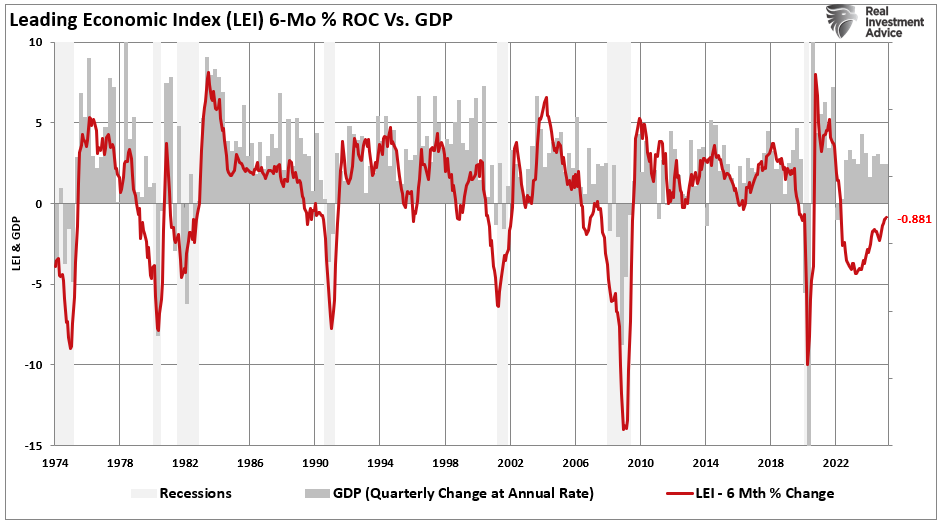
Lastly, credit spreads remain key to navigating an economic decline or a recession. We have discussed credit spreads in the past, but for investors, they are critical to understanding market sentiment and predicting potential stock market downturns. A credit spread refers to the difference in yield between two bonds of similar maturity but different credit quality.
This comparison often involves Treasury bonds (considered risk-free) and corporate bonds (which carry default risk). By observing these spreads, investors can gauge risk appetite in financial markets. Such helps investors identify stress points that often precede stock market corrections.
The spread below, risk-free versus the most risky (high-yield, or junk bonds), is the most important to watch.
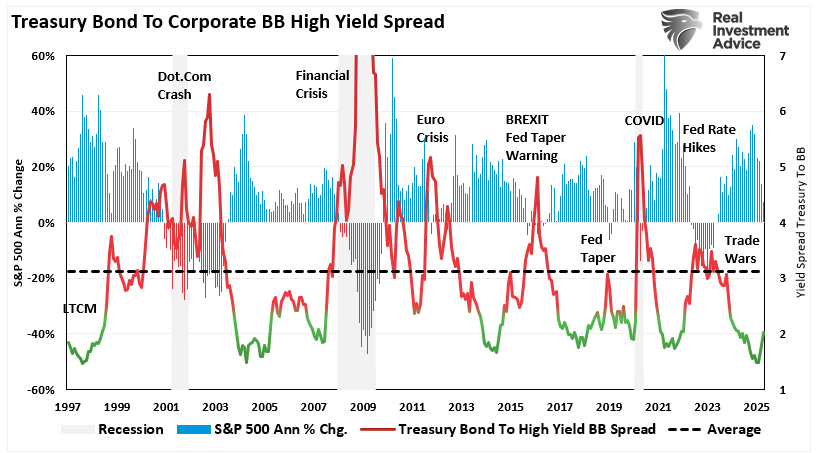
In the linked article above, we noted that this spread has been a reliable predictor of market corrections and bear markets and coincides with economic declines and recessions. This makes sense given that the high-yield bond market consists of debt issued by companies with lower credit ratings. Such makes them more vulnerable to economic slowdowns.
As such, when investors become concerned about economic prospects, they demand significantly higher returns to hold these riskier bonds. When that happens, the spreads widen, warning of increasing risks.
Historically, sharp increases in the high-yield spread have preceded economic recessions and significant market downturns, giving it a high degree of predictive power. According to research by the Federal Reserve and other financial institutions, the high-yield spread has successfully anticipated every U.S. recession since the 1970s. Typically, a widening of this spread by more than 300 basis points (3%) from its recent low has been a strong signal of an impending market correction.
Currently, that particular yield spread remains well contained. Still, when it reverses, it tends to do so quickly. As such, yield spreads are a better “real-time” indicator than lagging economic data.
The latest economic data confirms what we already knew: economic growth is weakening faster than many expect. For investors, that economic decline threatens the one thing markets care about: earnings.
Watching For Earnings Impact
While the first quarter earnings season has been okay, earnings over the next few quarters will likely be revised lower. So far, earnings estimates for the S&P 500 index (by S&P Global) remain extremely optimistic. In the last two months, S&P Global has raised its estimates for 2026 GAAP earnings (reported) from $289/share to $292/share.
As we have discussed previously, these estimates are exceedingly deviated from the long-term growth trend of earnings.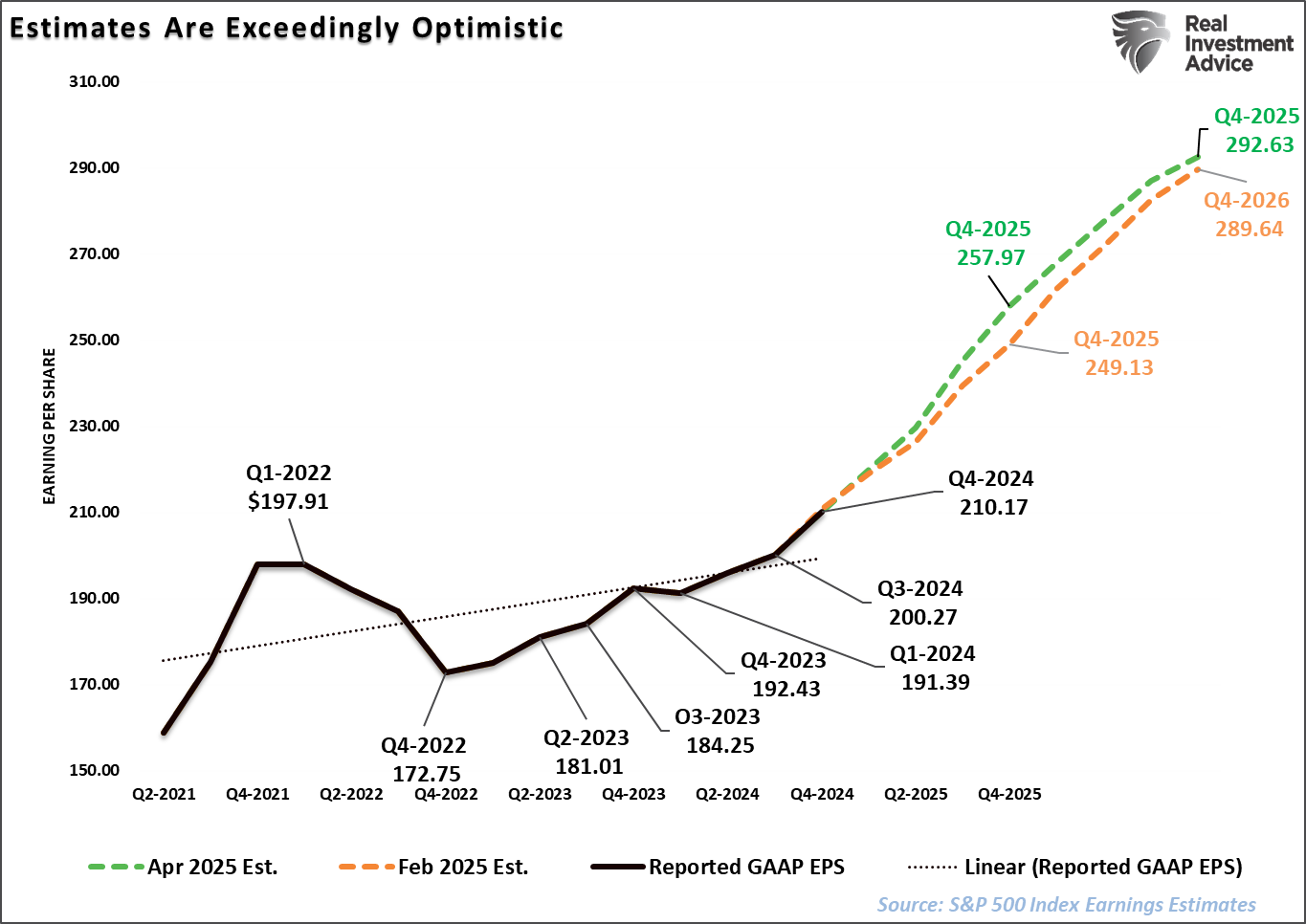
Such is particularly an issue for investors when economic data and inflation decline.
Historically, GDP growth has closely correlated with corporate earnings growth. Data from the Federal Reserve shows that, since 1948, a 1% increase in real GDP growth has translated to roughly a 6% increase in S&P 500 earnings on average. This relationship underscores why GDP is a cornerstone for assessing earnings trends. We can also see this visually.
“Since 1947, earnings per share have grown at 7.7% annually, while the economy expanded by 6.40% annually. That close relationship in growth rates should be logical, particularly given the significant role that consumer spending has in the GDP equation.” – Market Forecasts Are Very Bullish
A better way to visualize this data is to look at the correlation between the annual change in earnings growth and inflation-adjusted GDP. There are periods when earnings deviate from underlying economic activity. However, those periods are due to pre- or post-recession earnings fluctuations. Currently, economic and earnings growth are very close to the long-term correlation.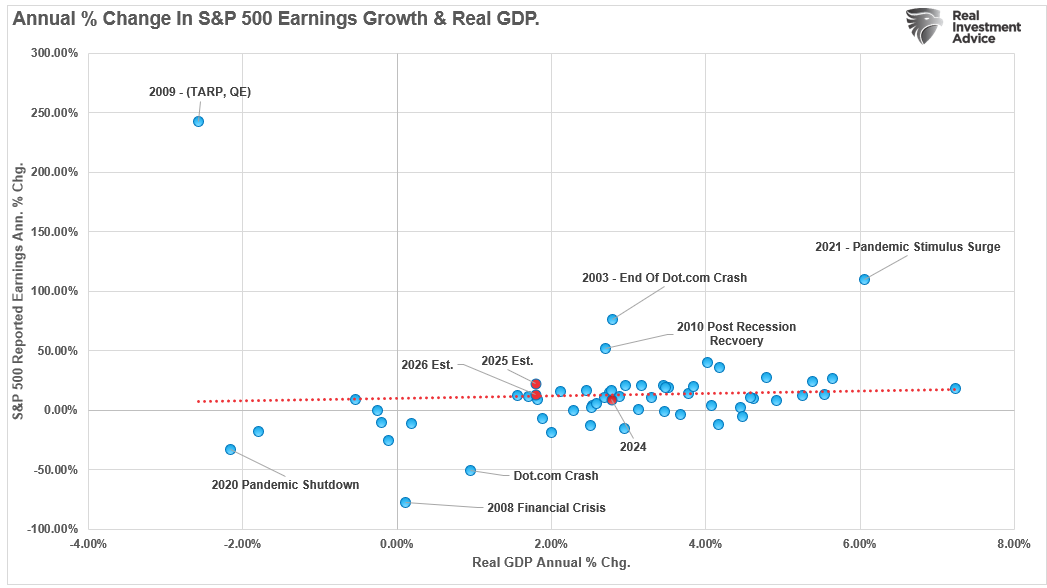
However, that assumes that GDP continues growing at roughly 2% annually. If economic growth deteriorates, as expected, then maintaining corporate earnings at projected levels becomes more difficult. Such is particularly the case when consumer confidence is contracting sharply, particularly in the outlook for higher incomes over the next 6 months.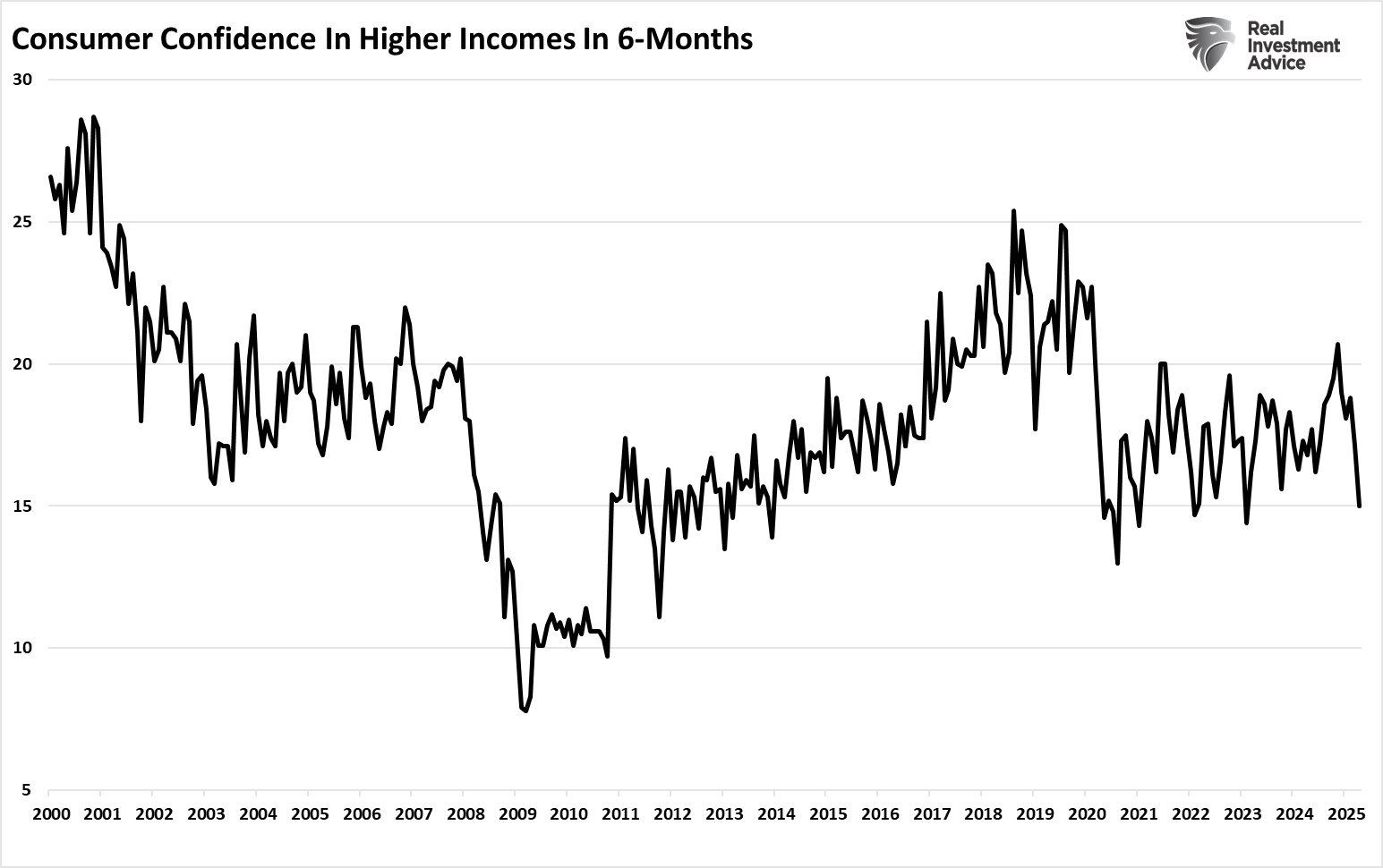
With expectations for incomes to decline and earnings tied to personal consumption, the risk of an economic slowdown should eventually be reflected in negative revisions to earnings expectations. That reduction in estimates will ultimately be reflected in the market price. Such is why there is a correlation between PCE (consumer activity drives earnings) and the annual percentage change in the stock market.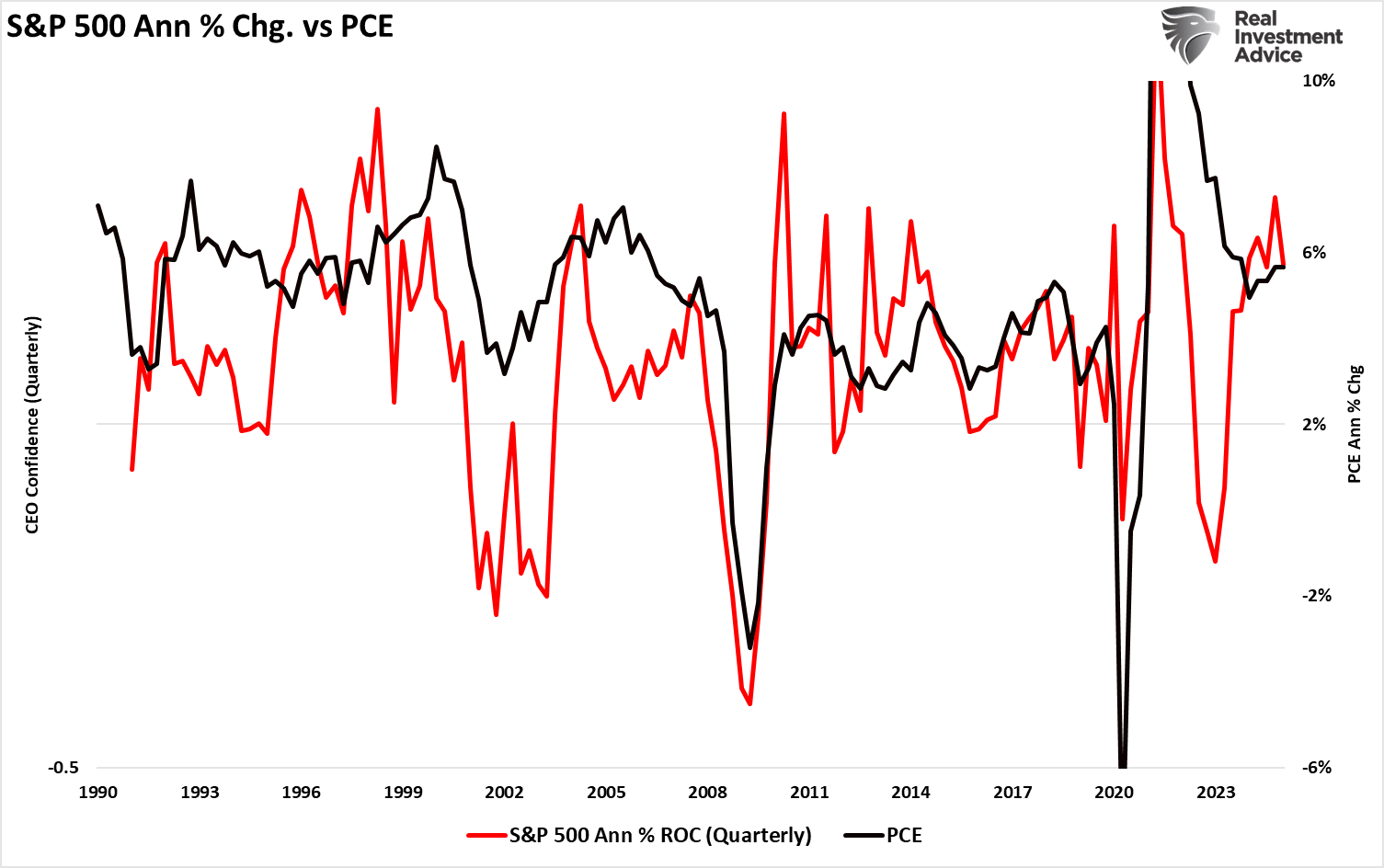
The incoming economic data is weakening, and there is clear evidence that the consumer is slowing down. While this does not mean a “recession” is coming, an economic decline is probable. As such, investors need to adjust their expectations for slower economic growth, increased market volatility, and lower forward returns.
How We Are Trading It
If the economy is slowing down and valuations adjust for lower forward earnings expectations, the most significant risk for investors is navigating market volatility. That doesn’t mean markets will crash.
However, it does suggest that many investors will fall victim to emotional mistakes in a sideways market. The need for a more conservative approach is rising, with forward returns lower and more volatile than promised.
The formula for investment success is controlling risk, reducing emotional investment mistakes, and limiting the destruction of investment capital. Here are some guidelines:
- Focus on capital preservation
- Forget about “beating the market” and target a rate of return sufficient to keep pace with the rate of inflation.
- Keep expectations based on realistic objectives. (The market does not compound at 8%, 6% or 4%)
- Realize that chasing higher rates of return require an exponential increase in the underlying risk profile. Such tends to not work out well.
- Remember that while you can replace lost capital – but you can’t replace lost time. Time is a precious commodity that you cannot afford to waste.
- Your portfolio is time-frame specific. If you have a 5-years to retirement but build a portfolio with a 20-year time horizon (increasing draw-down risk,) the results will likely be disastrous.
We continue to manage our portfolios with an above-normal level of caution. This week, we added to our short-market hedge and slightly increased the duration of our bond portfolio as the “basis trade” crisis we discussed two weeks ago seems to be under control. However, that risk is not entirely over.
As noted above, there is an elevated level of risk ahead as we approach the 200-DMA. The large supply of stock for sale and potential for continued weak economic data are key factors. While we don’t expect the market to crater to new lows unless there is another tariff or trade shock and a surge in recessionary data, a retest of recent lows would be unsurprising. As such, we are carrying an overweight position in cash and reduced equity allocations for now.
As an investment manager, we are neither bullish nor bearish. We view the markets through the lens of statistics and probabilities. Our job is to manage the inherent risk to investment capital for our clients. While it is true that markets have always recovered their losses, getting back to even isn’t the same thing as making money.
Have a great weekend.
(Note: The allocation below contains a 5% short S&P 500 position in the ETF allocation.)
